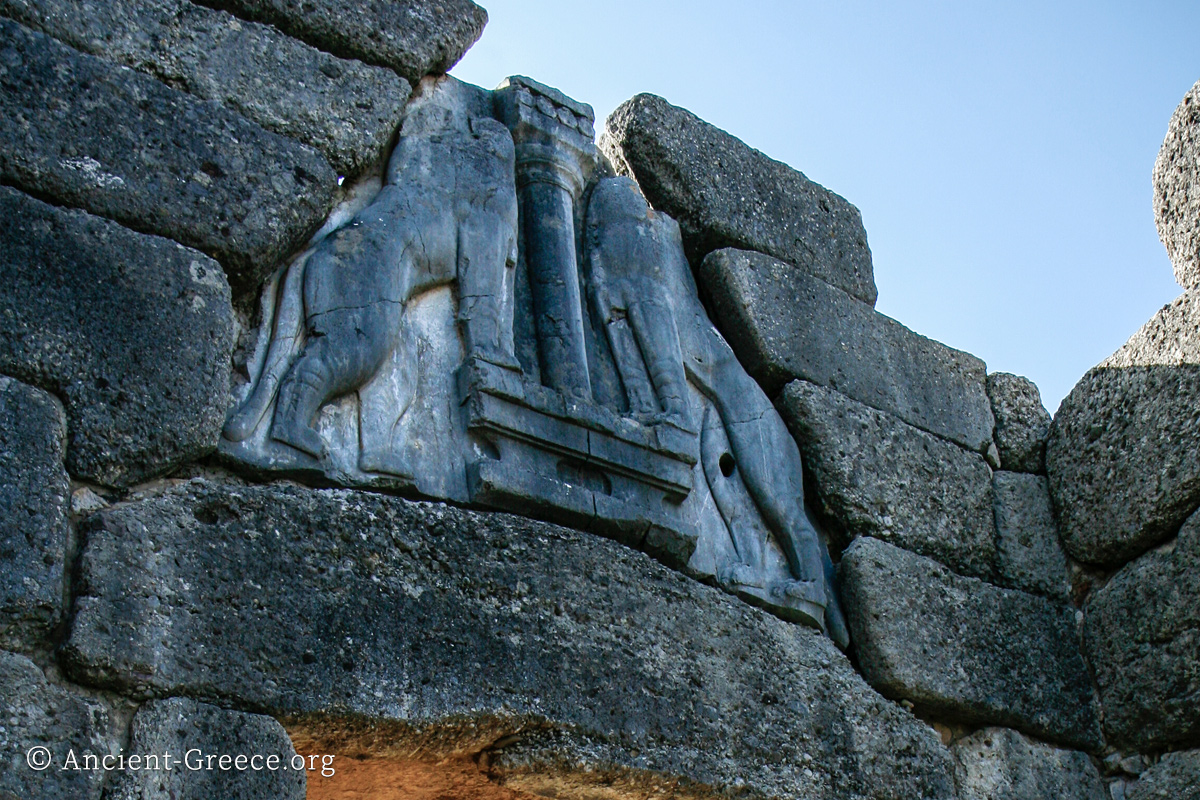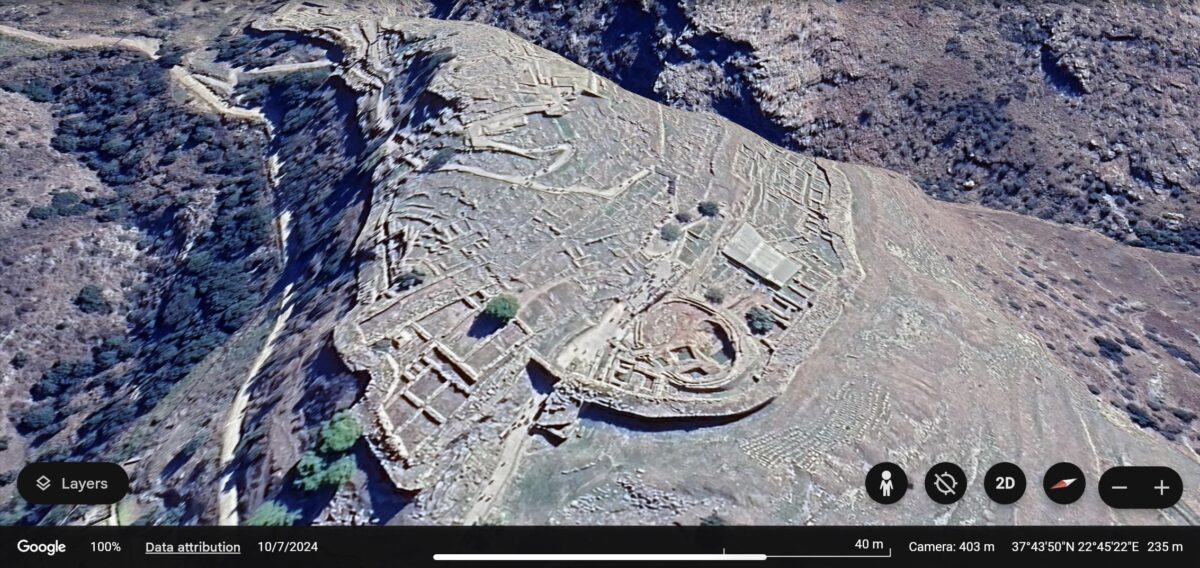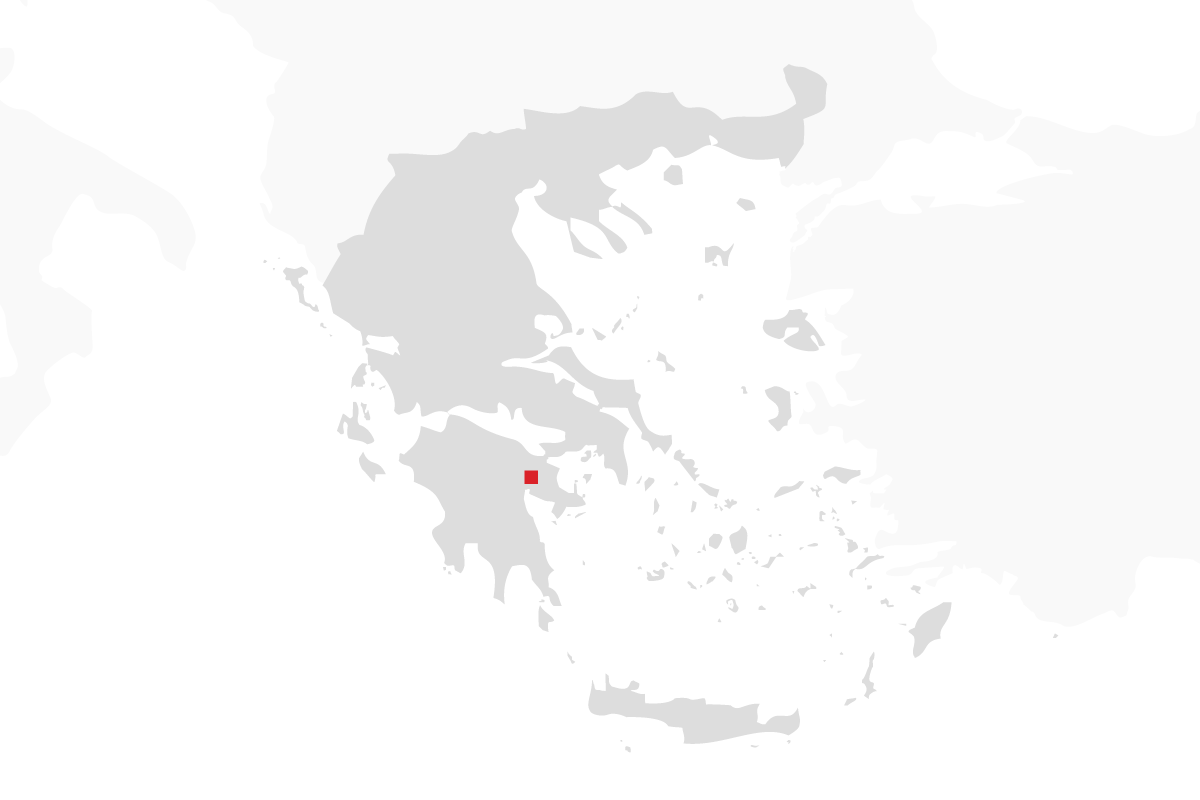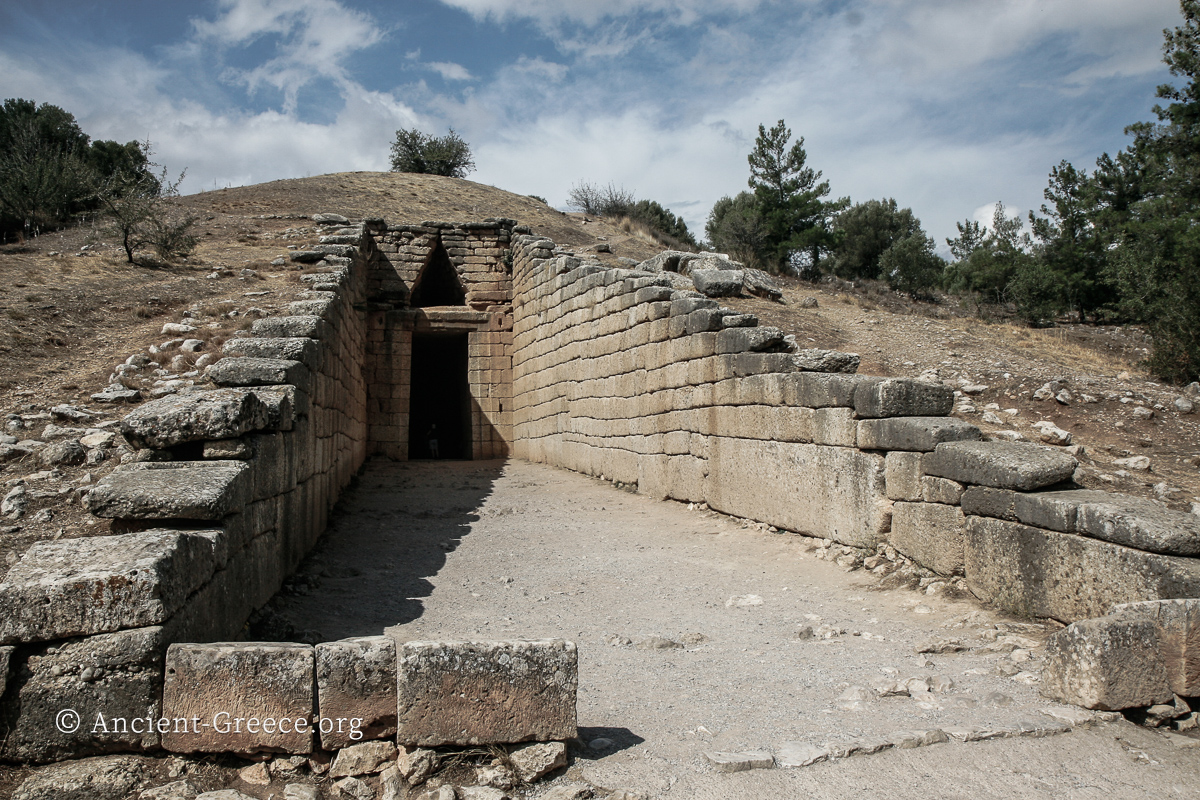
On this page:
Mycenae (Greek: Μυκήνες) is one of the most important archaeological sites of Greece. The fortified citadel is perched over the fertile plain of Argolis near the seashore in the northeast Peloponnese.
Mycenae is the largest and most important center of the civilization that was named “Mycenaean” after this very citadel.
History and Legends
Mycenaean is the culture that dominated mainland Greece, the Aegean islands, and the shores of Asia Minor during the late Bronze Age era (circa 1600-1100 BCE). The Mycenaean Era occupies the tail end of the Helladic Civilization, which flourished in mainland Greece since 3000 BCE.
Read more about the Mycenaean civilization.
Mycenae’s strategic location allowed it to control commerce between the Aegean and the mainland. Naturally, it grew over a period of a hundred years (1350-1200 BCE) to one of the richest and most powerful mainland centers of Bronze Age Greece.
The founding of Mycenae is lost in prehistory, but according to Greek legends, it was founded by the legendary hero Perseus – son of Zeus and Danae, daughter of the king of Argos, Acricios – who left Argos for Tyrins and later employed Cyclopes to build the walls of Mycenae with giant stones that no human could move (thus the characterization of the walls as “Cyclopean”).
The Perseid dynasty ruled the area from Mycenae from at least three generations. Eurystheus, the last of the line, was the one who commissioned Herakles (Hercules) to perform his twelve labors, and when he was killed fighting the Athenians, Atreus, the son of Pelops became the king of Mycenae and started the Atreid dynasty. Atreus’ son, Agamemnon led the expedition against Troy – the story immortalized in the Homeric Illiad – but was murdered by his wife Clytemnestra upon his return to Mycenae.
There are several explanations about how the place took it’s name. Homer indicates that it is named after a beautiful nymph called Mycene, while other theories credit the mushroom-shaped pommel of Perseus’ sword, or the local mushroom (mykes) he used as a cup to drink water on the site where the Perseia spring spontaneously appeared.
Mycenae Citadel


General view of Mycenae in its environment.
The Lion Gate




The Lion Gate guards and provides the main access to the citadel. The two lions arranged symmetrically around a column is the first example of representational monumental sculpture in the European continent. While its significance has been lost to the depths of history, its placement above the main gate of the most powerful citadel of late Bronze Age has led to speculation that it symbolized something important like a family crest of a coat of arms.
The triangular shape of the sculpture acts as a relieving triangle for the door below: its shape distributes the weight above the door to the sides and away from the horizontal lintel, protecting it form breakage. The relief sculpture is carved of gray limestone, but the heads of the lions were added on (probably made of steatite or metal) and have been lost since antiquity.
Flanked by cyclopean walls, the gate was closed by a double, heavy wooden door which was secured by a sliding bar. It is dated to about 1249 BCE, and it was added during the second building phase of the citadel.
Grave Circle A




Top: One of the most striking and significant features of the archaeological site is the excavated Grave Circle A seen in the photos above.
Grave Circle A has a diameter of 27m and it is located immediately to the right inside the Lion Gate. The circular burial area is enclosed by a double ring of upright dressed stone slabs which were probably filled with rubble and capped with more rectangular slabs to give a solid wall appearance. An opening in the slabs provided access to the burial site. Ten rectangular funerary stele marked the six shaft graves in which 19 skeletons were found interred in a contracted position.
This was the location of the royal burials that have yielded a host of priceless Mycenaean funerary artifacts, now displayed mainly at the National Archaeological Museum of Athens and at the Mycenae Museum.
The graves within are dated to the end of Middle Helladic and early Late Helladic Eras, and they were originally part of the expanded cemetery that lay outside the citadel, and were enclosed in the expanded wall sometime in the 13th c. BCE.
Bottom: Grave Circle A is visible on the right. Immediately to its left the square foundations belong to the complex where the Warrior Crater was found. The house group of the “oil merchants” is visible in the background of the image, outside the citadel walls.
The Palace




Chryselephantine (gold and ivory) statue fragments from the Archaic Era.
Cult Centre and East-End





Left: Ruins of the Cult Centre of Mycenae. It consists of five building complexes one the southwest slope of the citadel. They date to the early 13th c. BCE. Among the artifacts found in the ruins are the wall paintings and the clay figurines exhibited at the Mycenae Museum. The Cult Centre was destroyed in late 13th c. BCE and the site was occupied by houses which were used until the end of the Mycenaean period.
Three photos on the right: views from the excavations at the east end of the citadel, behind the royal palace (From left to right): Artisan’s quarter; House of Columns; Building Gamma, and Building Delta.
Northern Extension and Gate



From left to right: The Northeast Extension was constructed in the late 13th c. BCE. Its purpose was to safeguard the water supply and the underground cistern. It has two corbelled openings that lead outside the wall, one of which is visible in this picture. Visible to the right of the same photo is the second wall opening of the Northeast Extension. The next photo shows the second wall opening of the Northeast Extension – the one next to the underground cistern entrance – as it appears from the outside.
The Northern (Postern) Gate (right) was constructed during the second building phase around 1250 BCE. It was secured with a double wooden door bolted by a sliding bar.
The Cistern


Left: The underground cistern was an impressive engineering feat that allowed the citadel unlimited and secure water supply. Visible to the right of the same photo is the second wall opening of the Northeast Extension.
Right: The cistern’s entryway shows the corbelled tunnel to the underground water pool which was supplied through underground pipes from a nearby natural spring.
Grave Circle B



Grave Circle B is located outside the walls of Mycenae and predate Grave Circle A by three centuries (beginning burials estimated at 1650 BCE). The large circular wall contained 25 graves, and the funerary artifacts found in excavations were precious objects of gold, ivory, rock crystal.
The two photos on the left show several of the excavated shaft graves in Grave Circle B, while the photo on the right is of Grave Rho which is a built tomb, created later in the 15th c. BCE.
Tholos Tombs













Top row: Tomb of Clytemnestra. In the proximity of Grave Circle B, and overlapping part of it, is the Tholos Tomb of Clytemnestra. While its name implies that Agamemnon’s wife was buried in it, there is no evidence that this is the case. The area was buried during Hellenistic times and a theatre was constructed. Part of the stone seating of that theatre are visible in the (top left) photo above through the neat circular arc above and to the left of the Dromos. The tomb was looted by Veli Pasha during Ottoman occupation, but otherwise is in excellent shape and shows exceptional masonry craftsmanship.
Bottom row: Tomb of Aegisthus and the Lion Tomb.
The Tomb of Aegisthus is among the earliest examples of Tholos Tomb construction. It was built in the early 15th c. BCE and it’s mostly built by small stones (compare with the well dressed stones of the Clytemnestra and Agamemnon Tombs). Just like the other eponymous tholos tombs in the area whose name is includes a historical or legendary person, there is no evidence that Aegisthus was buried in this tomb.
The Lion Tholos Tomb is named thus due to its proximity to the Lion Gate. It is dated to the early 14th c. BCE.
Reconstructions




Scale models of Mycenae archaeological site as it appears today.


Related Pages





